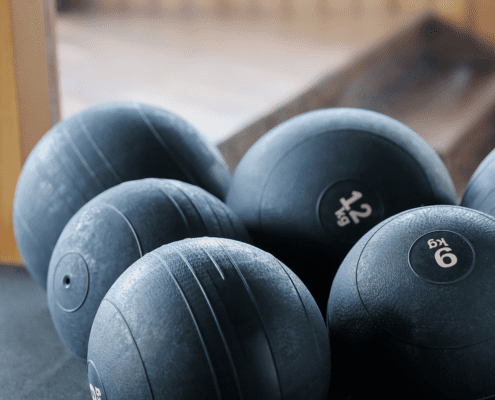Don’t Rely On “Flexing” Your Willpower Muscle To Lose Weight & Eat Better
Water follows the path of least resistance, people tend to do the same – but more from a habit pathway perspective. When it comes to eating healthy, and many other things, your environment has a huge impact. Flexing your “willpower muscle” is only effective for so long – at some point you’re going to want that cookie…a better approach is to set up a positive and supportive environment that helps make the healthy option the easy option.
Here’s a few strategies of how to set up your environment to make losing weight and eating better the easier option.
1. Make Healthy Options Visible
One way to encourage healthy habits is by visual reminders. By placing healthy foods on your kitchen island, or in your pantry and fridge at eye level you will end up eating them more often. Examples:
- Place fruits and vegetables in a bowl on your island, or somewhere in your kitchen where you will see them often.
- Don’t put your fruits and vegetables in the crispers, where they are “hidden” to spoil (at least this is what usually happens for me), put them somewhere more visible like the middle or top shelf – and at the front so they don’t get hidden and forgotten in the back.
If many “eye levels” exist in the family, then use the eye level for the one who’s in charge of food preparation and cooking.
Side note: marketers use this to their advantage in grocery stores, next time you’re at the grocery store look at the product placement of different items in terms of eye level. What you’ll notice is that different products will be placed at the corresponding “eye level” of their primary consumers, eg. kid cereals are typically on the bottom two shelves.
2. Place “Choose Less Often” Food Options Out of Sight
Similar to strategy #1, with the opposite purpose: keep foods that you overeat, or have a hard time not snacking on “Out of sight and Out of mind.” Not seeing these foods will prevent your habit associated with eating that food from triggering and you will start effortlessly eating these foods less often.
I use this strategy with peanut butter, because I’m a chronic over-eater and “over-portioner.” When It’s more visible I tend to eat it more.
3. Limit / Don’t Have “Choose Less Often” Foods Available or Accessible
Don’t buy and have “insert food type that you have a hard time not eating when it’s around” at home. This strategy isn’t something that all people can use, in particular families, but if you don’t buy certain foods they won’t be in the house for temptation. This isn’t to say you shouldn’t eat these foods from time-to-time, for example if you’re out at friends/family, but not having them in around you will limit your temptation.
I use this strategy with: Chips & Cookies, especially soft warm cookies…
4. Make Convenient Healthy Options Readily Accessible
The less nutritious and more calorically dense options are almost always quick and convenient. That’s why it’s not uncommon that these food types are over consumed, as many people are busy, on-the-go, and don’t always have time to make the healthy option. Some ways you can encourage making healthy options accessible:
- When making meals, always make more than one serving so that you can save time on making the same meal in the future and so that you have a healthy meal as a leftover. Or, make meals in bulk, like on a Sunday (my personal preference) to use later that week.
- Make sure you have fruits and vegetables that you enjoy in a fruit bowl on the table or in the fridge. Keywords being “that you enjoy,” there’s no point in having these options available if you aren’t going to eat them.
- Have pre-cut vegetables available, I like to get my clients to fill and eat a tupperware/container full each day. Read more about this.
5. Get Buy-In From Those Around You
Make those around you aware of what your goals are, and ask for help to help create a positive environment for your goal. This could mean asking your husband/wife to not insist on dessert, or openly snack on chips in front of you. Or, this could mean that your co-workers don’t guilt trip you when they are going for drinks after work and instead understand what you’re doing to help and support you.
The above is not an exhaustive list of things you can do to help you eat better without having to “flex” your willpower muscle. But, understand that willpower and discipline is a finite resource. The more you have to use your will power and discipline throughout the day, the harder it gets to use it afterwards. Some have more will power than others, but a commonality amongst those that succeed with their diets is that they don’t have to make as many decisions about the foods they shouldn’t eat. Said differently, they don’t have to restrain themselves from eating certain foods as much.
Your brain is hard-wired to make you eat. Understand that and accept that you’re not “weak.” Using discipline alone to curb food cravings is very challenging and usually only successful short-term. Also know that “amount of willpower and discipline” you have at the start of any given day is affected by many factors – sleep and mood being two big ones. Use this knowledge to your advantage, and the tips above, and you’ll find that you’re able to eat healthier with a lot less mental effort because the healthier option is the easy option.
Till next time,
-Mike
About the Author: Michael Fouts
Mike is the Owner of OverHaul Fitness. He has helped many clients successfully lose weight; and keep it off. In his spare time you can find him eating sandwiches (the solid, or liquid barley form: Beer), watching thought provoking movies or tv series (like Westworld), or doing something active like squash, hockey, or training for triathlons. Click on the link above, or HERE, to read more about Mike.
Related Posts:







